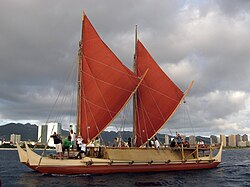References
- ↑ Gladwin, Thomas (1970). East Is a Big Bird; Navigation & Logic on Puluwat Atoll. Cambridge Massachusetts: Harvard University Press. ISBN 0-674-22425-6.
- ↑ Michael McCoy (1973). "A Renaissance in Carolinian-Marianas Voyaging". Journal of the Polynesian Society, Auckland University. Archived from the original on 2021-12-28. Retrieved 2015-01-09.
Then, in 1969, David Lewis visited the Central Carolinian island of Puluwat in his auxiliary ketch, the Isbjorn, while investigating ongoing systems of navigation throughout Oceania. Lewis had heard that the navigators of Puluwat possessed the knowledge to sail the 900-mile round-trip to Saipan, and upon arrival there asked one of the navigators, Hipour, to accompany him on the Isbjorn and navigate the vessel to Saipan and return. It was understood that only the indigenous knowledge that had been taught Hipour by the navigators of Puluwat would be used. The successful completion of this voyage, plus other factors, has led to a renaissance in Carolinian-Marianas voyaging and strengthened ties between Carolinians and their cousins on Saipan.




